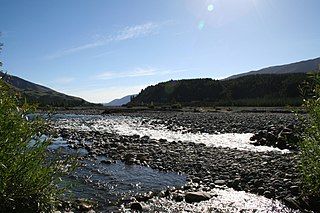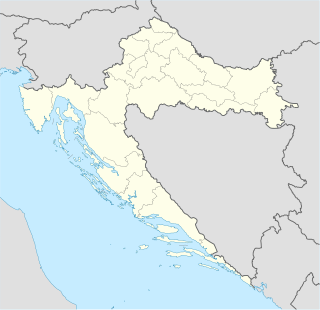The Severn River is in the South Island of New Zealand. The headwaters of the river are in the Raglan Range and it flows into the Acheron River. One of its tributaries is the Alma River.

The Waiau Toa / Clarence River is on northeast South Island of New Zealand. It is 230 kilometres (140 mi) long, which makes it the eighth longest river in New Zealand.

The Wairau River is one of the longest rivers in New Zealand's South Island. It flows for 170 kilometres (110 mi) from the Spenser Mountains, firstly in a northwards direction and then northeast down a long, straight valley in inland Marlborough.

Klis is a Croatian town located around a mountain fortress bearing the same name. It is located in the region of Dalmatia, located just northeast of Solin and Split near the eponymous mountain pass. It has a population of 2,621, totalling 4,421 together with the eight other villages in its municipality.

Čepin is a town and municipality in Osijek-Baranja County, Croatia. It is located in northeast Slavonia, 10 kilometers southwest from Osijek.
The Fairhall River is a river in the Marlborough region of New Zealand. It arises near Blairich Pass and flows north-east to join the Ōpaoa River between Renwick and Blenheim. The locality of Fairhall is east of the river. The river and locality were named in 1847 for a chainman in a survey team in the area.
The Horahora River is a short river of Northland, New Zealand. It is formed from the confluence of the Waitangi River and Taheke River, which meet close to the Pacific Ocean coast 12 kilometres (7.5 mi) northeast of Whangarei. It flows into the Pacific at Ngunguru Bay, three kilometres south of Ngunguru.
The Mangamuka River is a river of the far north of the Northland Region of New Zealand's North Island. It flows generally south from the Maungataniwha Range southeast of Kaitaia, and the last few kilometres of its length are a wide, silty arm of the Hokianga Harbour, which it reaches 10 kilometres (6 mi) northeast of Rawene.
The Mangatete River or Mangatete Stream is a river of the Northland Region of New Zealand's North Island. It flows northwest from its origins to the east of Kaitaia, reaching the Rangaunu Harbour to the east of Awanui.
The Mataroa River is a river of New Zealand. It is a tributary of the Northland Region's Whakapara River, which it meets close to the settlement of Opuawhanga.
The Ngunguru River is a river of the Northland Region of New Zealand's North Island. It initially flows southwest before turning east to flow into a long, wide estuary which empties into Ngunguru Bay to the northwest of Whangarei. The town of Ngunguru sits on the estuary's north bank at its opening to the bay.
The Oaro River is a river of the north Canterbury Region of New Zealand's South Island. It flows south from its sources in the Hundalee Hills, turning east shortly before reaching the coast at Oaro, 15 kilometres (9 mi) southwest of Kaikoura.
The Omaka River is a river of the Marlborough Region of New Zealand's South Island. It flows north from the slopes of Mount Horrible 30 kilometres (19 mi) west of Seddon, reaching the Ōpaoa River at the eastern end of Renwick.
The Orira River is a river of the Northland Region of New Zealand's North Island. It flows southwest, and for much of its length it is a northwestern arm of the Hokianga Harbour.
The Oruru River is a river of the Northland Region of New Zealand's North Island. It flows north from its sources south of Mangonui to reach the Taipa River 5 kilometres (3 mi) from Taipa.

The Rai River is a river of the Tasman Region of New Zealand's South Island. It flows predominantly south, reaching the Pelorus River at Pelorus Bridge. The township of Rai Valley is located close to the river's banks.
The Tawapuku River is a river of the Northland Region of New Zealand's North Island. It flows generally southwest to join the Awarua River 40 kilometres north of Dargaville.
The Victoria River is a river of the Northland Region of New Zealand's North Island. It flows generally northwest from the Maungataniwha Range, reaching the Awanui River to the east of Kaitaia.
New Zealand's largest Manganui River is a river of the Northland Region of New Zealand's North Island. It follows a generally westward course from its sources west of Ruakaka before its outflow into the Wairoa River 5 kilometres (3 mi) east of Dargaville. The river's lower course is noted for its convoluted, winding path through low-lying swampy terrain, and several oxbow lakes are associated with this stretch of the river.
Martin Reef is a reef awash, lying 7 nautical miles (13 km) north of the coast of Antarctica and slightly west of Cape Fletcher. This reef was apparently encountered by Captain Carl Sjovold in the Norwegian whale catcher Bouvet III in January 1931, and by the British Australian New Zealand Antarctic Research Expedition under Douglas Mawson in February 1931. It was named by Mawson for the boatswain of the Discovery.







